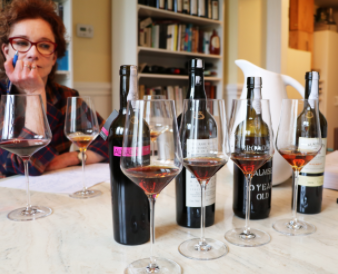Posted: Jul 03, 2017
 Source: Wine Speed | Karen Macneil
Source: Wine Speed | Karen MacneilForward by Go-Wine: The author of this summary on Madeira is world renowned Karen Macneil. She is the author of The Wine Bible.
Astrophysicists say that the two best states to be in are wrong or confused, because then everything around you becomes exciting and open to discovery.
I was thinking about this gem of an idea that other day while staring at a bottle of Madeira, one of the most exciting wines in the world—and, come July 4th, the wine you should be drinking. Historically, Madeira was once the single most popular wine in the Unites States; the chardonnay of its day.
Drunk by the founding fathers during the signing of the Declaration of Independence, Madeira was also what Francis Scott Keyes sipped as he composed the Star Spangled Banner. George Washington (who reportedly drank a pint every night with dinner), Thomas Jefferson and Benjamin Franklin all adored it, as did John Adams (who wrote to his wife Abigail about the copious amounts they consumed during the Continental Congress.) By the end of the eighteenth century, nearly a fourth of all the Madeira produced was being exported to the American colonies. Among the colonial well-to-do, Madeira “parties” –forerunners of the American cocktail party–became commonplace.
Madeira’s first big heyday may have passed, but I like to think we’re a little bit “wrong” in not drinking more of it. Part of the reason is the place it holds in the world of wine. Madeira (along with Champagne, Sherry, Port and Tokaji) is one of the “Five Greats”– wines that if they weren’t already invented, never would be invented because they are so painstaking to make; wines that are the products of centuries of tradition, skill, and artisanality. To drink a fine Madeira is almost mind bending in its pleasure—first because the wine is so damned delicious, but second because one cannot help but marvel at the sheer intellectual impossibility of creating it.
Madeira is fortified, oxidized, and maderized. The best are aged twenty years up to two hundred years before they are released. The flavor of a great one is almost impossible to describe—a rivetting synthesis of toffee, butterscotch, cocoa, curry, and caramel. It’s the only wine I know of that pairs exquisitely well with really good chocolate (a flavor so profound itself that it usually swallows up wine whole). Here, in short, is Madeira’s story.
The wine Madeira comes from a small cluster of volcanic islands, the largest and most important of which is also called Madeira. Although the islands are geographically part of Africa (about 300 miles off the Moroccan coast), they are nonetheless a province of Portugal, some 600 miles to the northeast. The islands were discovered around 1420 when the Portuguese explorer Prince Henry the Navigator mandated that the coast of Africa be explored to establish a provisions base for ships bound for the East Indies or the Americas.
The wine—which can be bone dry or opulently sweet—starts out much as any other wine. The grapes are harvested and fermented. Then, brandy is added to halt the fermentation and possibly, leave some natural sweetness. Next, stunningly, the Madeira-to-be is heated (maderized)—either in specially designed tanks or traditionally, in casks in hot attics. The wine reaches about 130 degrees Fahrenheit and remains at that temperature for months, years or even many decades. Importantly, the casks are not filled to the brim. The combination of time, heat, and oxygen has a superb mellowing effect on the wine, creating an inimitable velvety texture and complex, hedonic flavor.
But the Madeira isn’t quite done yet. After it’s allowed to cool and rest, a Madeira is then aged for potentially another twenty years, often in casks made from different woods—American oak, chestnut, Brazilian satinwood, even mahogany.
At this point the flavor is off the charts delicious. Really, who wouldn’t have been inspired while writing the Declaration of Independence?
Two favorite Madeiras:
THE RARE WINE COMPANY Historic Series Madeira “Boston Bual” Special Reserve (Madeira, Portugal) $50 95 points
RWC’s “Boston Bual” is nothing short of sensational. Languorous on the palate, it fairly howls with coffee, toffee, sassafras, exotic spice, roasted nut, sea salt and orange peel flavors. Try this in the early evening with a fine hard cheese like Manchego, Mimolette or aged Gouda.
BLANDY’S 1996 Malmsey Colheita Madeira (Madeira, Portugal) $56 for the 500 milliliter bottle. 95 Points
A colheita (col YATE ah) is a relatively new, rare type of Madeira from a single vintage. (The very first one was Blandy’s 1994). I love the roasted nut and apricot intensity of this wine. Sweet, but not saacharin, it’s stunningly long on the palate, with a slow, lingering fade-out like an old French movie.
By Karen MacNeil
June 22, 2017
Source: WineSpeed
Go-Wine's mission is to organize food and beverage information and make it universally accessible and beneficial. These are the benefits of sharing your article in Go-Wine.com
 Source: Wine Speed | Karen Macneil
Source: Wine Speed | Karen Macneil
The Wine Thief Bistro & Specialty Wines is a locally owned small business in downtown Frankfort, IL offering world class wines in a relaxed, casual gathering spot for friends and family. Offering world class virtual tastings and touchless carryout.
https://www.twtwineclub.com/aboutus
Go-Wine 25 Great Wineries in US selection prioritizes quality, value and availability.
www.go-wine.com/great-wineries-in-america
Tasting wine is a nice experience, but visiting the places in which wine is made is a magic moment. Available in New York City for touchless pickup.